I recently broke down and bought a Tenkara USA Ito after hearing a lot of buzz and positive reviews on it. To be honest, my first experience with the Ito didn’t make a great impression on me. I had cast one a few times and thought it was too slow and longer than I really needed. But what I didn’t realize was that the Ito grows on you and once you fish it a few times and drop some preconceived notions, you finally realize it’s full potential and advantages.
The Action
While the Ito is rated as a 6:4 action, it’s different than any other 6:4 tenkara rod I’ve fished. It feels significantly slower in the hand. I’m used to fishing a 6:4 Iwana or 6:4 Amago–both of which feel stiffer than the Ito so I would call it a “soft” 6:4. It is a pleasure to cast if you slow down your casting rhythm and let the rod do most of the work. I find that I don’t have to move my arm as much and the rod is very responsive with even the slightest of movements. This might take a little adjustment period for those used to casting faster rods where you have to do more work but once you get it, it feels pretty sweet.
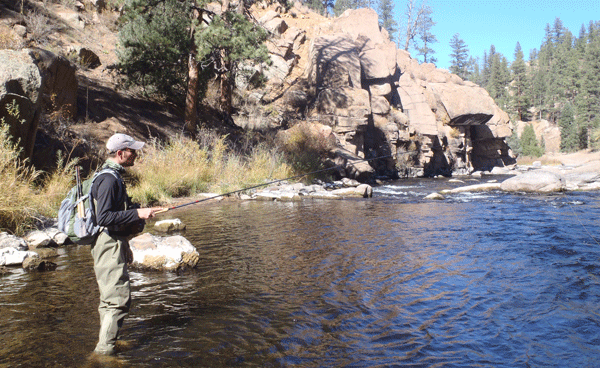
Me fishing the Ito on the South Platte
The Zoom Feature
The Ito is a “zoom” rod which means it can be fished at two different lengths–13 ft. or extended to 14 ft. 7 in. As expected, there is a noticeable difference between the two lengths. When in 13 ft. mode, the rod feels unexpectedly light thanks to the way the handle moves the focal point of your grip a little higher. At the fully extended 14 ft. 7 in. length, the rod does feel more tip heavy and slower, but still not as much as I had expected at such a mammoth length.
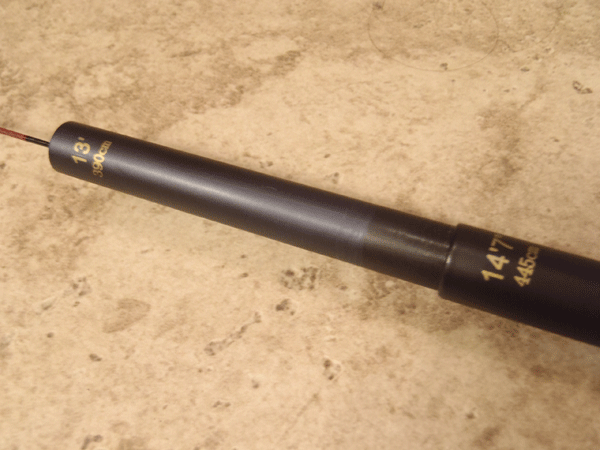
Markings on the blank tell you which length you’re fishing
Overall, I prefer the way the 13 ft. mode casts and feels in the hand. This is the way I fish it most of the time. But it’s nice to be able to instantly adjust the rod length when you need a little extra reach, then go right back to the “sweet spot” of 13 ft. when you don’t.
I’ve fished the rod on both small streams and larger rivers and the adjustable length lets me handle both well. And while it might seem like a “big” rod, the softer action doesn’t pigeonhole it as a “big fish” rod–meaning that it’s still fun to land smaller fish with it.
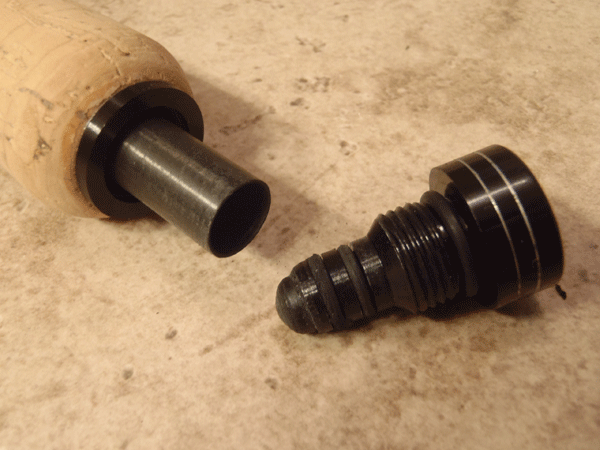
Length is adjusted by locking a segment of the rod into place with o-rings in the end cap
The Finishing Touches
The Ito is definitely a premium rod. Every component is well-made, high-quality, and I feel it’s worth every penny of the slightly more expensive cost of other Tenkara USA rods (especially when you consider it’s versatility).
The cork grip is one of the best I’ve seen and every detail is well crafted right down to the winding check, rod plug, and end cap:
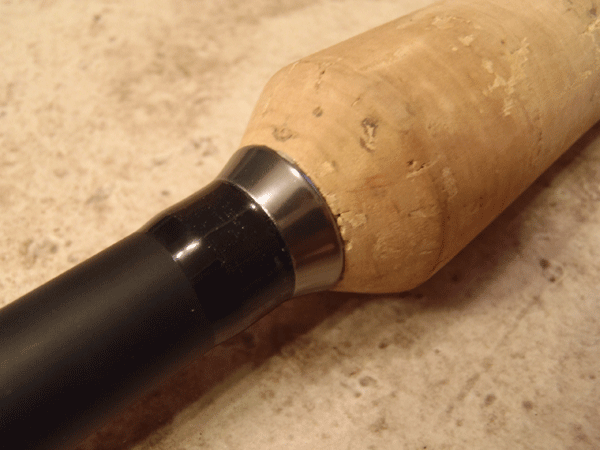
Ito Winding Check
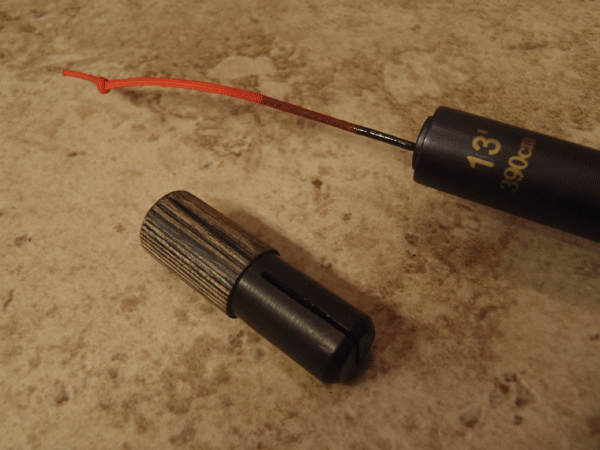
Signature (and very cool) Tenkara USA Wooden End Plug
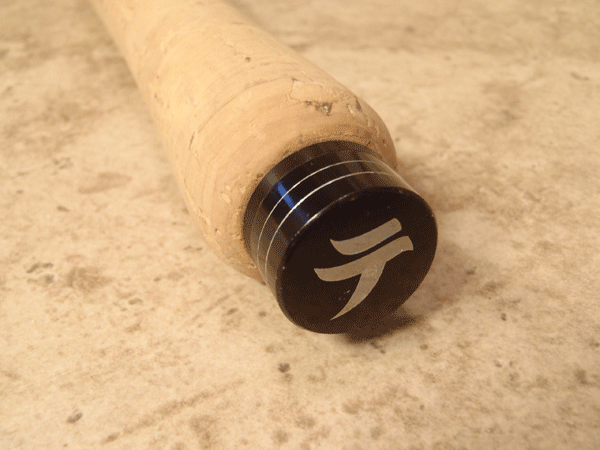
Ito End Cap
Aesthetically, the Ito is a beautiful tenkara rod with a matte black blank and dark blue accents. The specs and length demarkations are in gold:
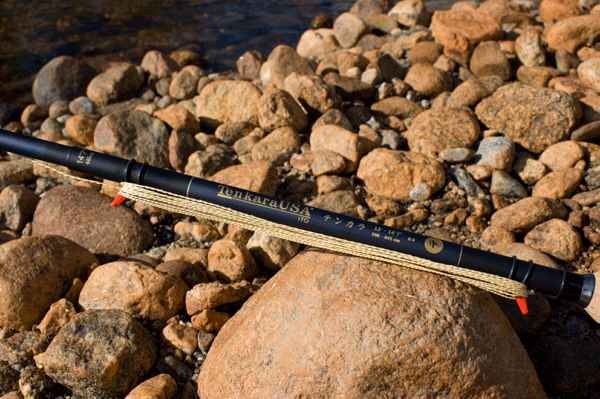
Ito Blank Closeup
The collapsed length is longer than other Tenkara USA rods at just over 21 in. but I’d still deem it compact enough for backpacking and those looking to go minimal.
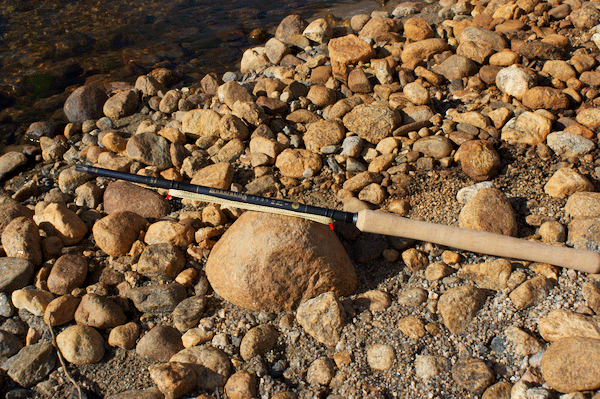
Ito Collapsed
Conclusion
The Ito probably isn’t for everyone. But that’s why they make different tenkara rods. Overall, I have to say this is currently my favorite tenkara rod. I love the way it casts and the ability to instantly adjust the rod’s length. The zoom feature essentially gives you 2 rods in one and I love that versatility. It turns large rivers into small streams without having to cut or tie on more line saving valuable fishing time. In fact, I love the action of the Ito so much, I actually took a break from finishing this post to go cast the Ito in my back yard. Yeah…it’s that cool.


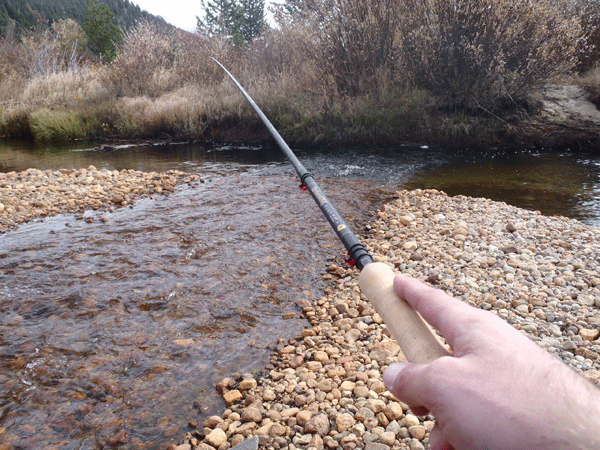






Thanks for posting the review, I’m looking forward to my Ito arriving soon.
Let us know how you like it Thom!
Right on the ball Jason. I actually disliked the rod when I first got it, but after a days fishing it opened my eyes. I too prefer the collapsed length, it balances perfectly in the hand I find the extended length gets tiring all day.x
What I found is that fishing a short lineon theito is still fishing 20ft or more away. It handles a 20ft line with ease, and that lets you fish a seam over 30ft away in true tenkara style. Poor fish don’t even know you are there. . It excels on riverrs that have some space, such as the open rivers in NZ or Australia. It isn’t the rod for closed in streams that are common on smaller streams e in eastern Australia or NZ, but the Iwanna covers these.
You are also spot on about the casting. You need to slow right down. If you try to cast as though you have an iwana in your hand, you find out quickly that the Ito doesn’t like being handled this way. I need to slow right down and paint the cast.
Great rod for wide open rivers, has its place.
Craig
Jason, great review and I have to agree on all points. Me, too, I didn’t like it as much when fishing it earlier this year. But now that I have some more fishing time under my belt with the ITO it really grew on me and I reach for it first before any other rod (if the type of stream allows it).
Try it with the 10# Carbon Gold line ( which is 2.5 on the Japanese scale ) and the Tbum Hi-vis 3. Both lines open up this rods capabilities. I’ve been fishing it extended length with 12 ft of Tbum’s 2.5 pink flouro. A yummy combination.
I tried the carbon gold line but like the visibility of the Tenkara bum lines better. Just curious why you like the 12ft. Length rather than something longer. Is it for smaller steams?
Tenkara is for small streams. The further away you get from small streams , the less well it works. I’ve tried it almost everywhere -big rivers , tailwaters, even saltwater.
I have fished the Ito with lines as short as 8 ft. It is like a vacuum cleaner in pocket water.
Line visibility isn’t an issue for me as I fish in close and rarely look at the line.I look at my fly and the water where it is/should be.
I spent years fishing CO back in the 70’s and fished the same way then as I fish with tenkara gear now. Tenkara is easier. Much.
Great review! I can’t wait to get my hands on my Ito. Unfortunately, it won’t be until Christmas, but I predict a fishing excursion on the 26th!
That will be an awesome Christmas gift Charles! It’s not that far away.
Jason your review was dead on the money for me. when I first got my Ito I did not like it since it was so different from my Iwana. Now that I have gotten used to it, it is by far my favorite, and I find it hard to even find a reason to use my Iwana. its kind of like when we all switched from vhs to dvd, I thought ” ah its not that much better” but have you looked at a vhs recently …bleh! what a mess 🙂
Very nice rod…I’ve always thought about taking one out with me when I’m hiking. I’m not a pro like you though..:P
Jason, has the Ito become your preferred rod for high lake fishing because of its additional length over the Amago, or do you still prefer the Amago because of its ability to cast heavier lines and handle wind better?
I have a 12 foot Iwana and like its faster action very much. I am considering a second Tenkara rod. I bought the 12 foot Iwana because I wanted an all around rod to also fish high lakes with. Although I also fish some very small, brushy streams, a short line and the bow-and-arrow cast has solved most of my small stream fishing Tenkara problems on these tight creeks. As a matter of fact I have trouble believing how effective the 12 foot rod has been on our small streams here in the Sierra, some of which I used to fish with a 5 foot 8 inch fly rod to be able to cast under the tree limbs, while I was on my knees in the water to get enough casting room even then. But I have not fished my 12 foot rod on that creek, yet.
I am not overly concerned with a “big fish” rod, which the Amago surly is. I had a little trouble hooking fish in the beginning with my Iwana because of its soft tip, compared to what I was used to using with my western fly rods, I prefer Scott G2 rods, which are noted for their soft tips, that are great at protecting light tippets.
I have been playing around a lot with lines lately, made up several weights in level lines and casting them was a real eyeopener for me. With my rod, I bought the Tenkara USA’s 10.5 foot furled tapered line, which I didn’t particularly like because of the twisting and kinking problems I had with it, although it casts quite nicely. Next I tried some of my hand tied lake leaders, which actually worked out pretty well. I have tied up a weight forward tapered line of my own, which I hope will solve some of my wind problems on the lakes.
Just as you have also discovered, most of my presentations on the high lakes are made to shore cruising fish, often made with terrestrial fly patterns, but cast into the wind to get drag free drifts as the fish approach the fly. Casts are usually short because the fish are patrolling the shallows in the splash-back zone, located close to the shoreline. Stealth is a must and a longer rod is a decided advantage in these kinds of situations. The trout, whether brook trout, rainbows or golden trout, will often charge the size 12 to size 16 floating foam patterns from a considerable distance away. An 8 to 10 foot fly put down points are usually plenty close enough to get the desired results, so you can easily cast to trout a good distance away from you, considering their strike response distance,line and rod lengths. The trout can feel the fly landing with a splat on the water with their lateral lines, and usually respond accordingly.
Something you may not be aware of: As you know running water midges mature in a matter of a few weeks to a couple of months and are quite small to very tiny. Lake midges, on the other hand, are on a two year or longer life cycle, and grow to considerably larger size than running water midges achieve. I have found midge pupa shucks in lakes above 11,400 feet in elevation that were easily a size 8 in size. My most effective midge pupa patterns are tied on size 10 through size 16 hooks, tied on TMC’s 2488 Emerger Hook. I don’t bother fishing with midge larva or adult patterns at all, just pupal and emerger patterns, although the Griffith’s Gnat is a very good and effective fly pattern.
In lakes, I fish midges when the fish are working to midges, which is mostly in the mornings and evenings, but also in the warmest part of the day early and late in the lake fishing season. My Sheeps Creek patterns, fished subsurface, are fished after the trout quit working to the midges but before fishing my terrestrial patterns, ants, beetles and high country hoppers, which are fished after it becomes windy with the up-slope thermal winds developing from mid-morning through mid-afternoon later on in the day on most days, which seems to work out best 80 to 90 percent of the time on the high lakes for me.
For me, the Tenkara technique is not as effective with subsurface fly patterns as it has proven to be with floating fly patterns, whether you are fishing in streams or lakes. This was my first Tenkara season, and I am still discovering the possibilities and working on my presentations to get better results. On running water I do not fish anything but dry flies as a personal preference. I do not have any objections to anyone else fishing with what ever they enjoy using.
On my last high lake fishing trip, I did not even take my western fly tackle along. I got a Guide model Ebira and I wanted to try traveling light – hemostats, nippers, bug dope, some chapstick, an assortment of Tenkara fly lines, and one box of flies. I fished with a friend who was using standard issue western fly tackle, 9 foot for a 5 wt line rod, 9 foot tapered leader, who could easily out distance my Tenkara casts by a factor of better than 4 to 1. We fish pretty much the same fly patterns: Sheeps Creeks and ant patterns. I gave him his choice on which way to fish around the lake first. We passed each other in the center of this small timbered lake, so we each fished pretty much the same water, eventually. I landed 16 brook trout, John landed 2 brook trout and a rainbow trout. I was using a 10 foot line, including the tippet and fly on my 12 foot Iwana rod. The difference was that I was forced to be stealthy because of my very limited casting range with my Tenkara tackle, and I believe I did better because of my careful and patient approaches to the water and to the fish. I am building a lot more confidence in Tenkara’s abilities to produce decent catches on the high lakes. I also had a 78 golden trout day on another high lake with my Tenkara tackle earlier in the summer this season.
So Jason, please let me know what your thoughts are regarding the Ito and Amago rod models for high lake angling. Every once in a while I happen into a 19″ or better fish, but not very often. Not often enough, for sure, to go with a dedicated big fish rod. I want to have fun with the fish I catch most of the time, trout between 9 and 13 inches in length, and I believe I can also adapt to a rod that is slower in action than my 12 foot Iwana rod is, over time…Thank you for your time…Karl.
Hi Karl,
OK, you officially win the prize for the longest blog comment ever. So, email me your address and I’ll send you a little tenkara gear “thank you package” in the mail.
As for the Amago vs. the Ito, I think both are excellent lake rods. If you prefer a little more stiffness and don’t need the extra foot, the Amago is a great choice. You might also find it easier to cast in the wind.
The Ito will give you the extra reach and will definitely handle the occasional larger fish. People have caught up to 20″ fish with it so I don’t think that would be a problem. Since you say that you usually find the fish close to shore, maybe you don’t need the extra length. The Ito is a slower action so wind can be more of an issue so given everything you said, I would say that maybe the Amago is a better choice for your second rod. It’s a nice paring with the Iwana 12 ft. to handle a wide range of situations–everything form lake fishing to small streams.
It’s funny you mention the TMC 2488 because that’s one of my favorite hooks for small flies (particularly lake flies). I use really small 2488s and tie a variation of the Griffith’s Gnat. It’s basically a typical Griffith’s gnat for the thorax with a tag of pearl krystal flash for a tag. Works great and with the short shank and the wide hook gap allows me to give the impression of a smaller fly without losing hookups.
Jason, Thank you for sharing your thoughts on the rods and the information on the hooks and flies. This fishing season is about done for here for me. Now I have Cross-country ski season to look forward to. Our stream trout season runs from the last Saturday in April to the 15th of November. Lakes are open year around for trout fishing, but the snow effectively closes down the back country, so my rod purchase will be made some time in the spring. You have given me a lot to think about; thanks for your help…Karl.
Thanks Karl! Enjoy the ski season!
Jason, after giving what you said a little more consideration, I believe that I am going to go with the Amago rod for my high lake fishing. For all the reasons you mentioned, but also because of its shorter overall pack length than that of the Ito rod.
My favorite western backpacking rod for lakes is Scott’s G84-5/5, an 8 foot 4 inch, 5- weigh/ 5-piece travel rod, with an overall rod tube length of 23 and 3/8ths inches. I also have a Scott G90-5/4 travel rod, which is a 4-piece, 9 foot rod for a 5-weight line that fits in a 30 and 1/4 inch rod tube, which I find much more troublesome to backpack. The 5-piece rod has a slightly slower action with a somewhat softer tip, but I can cast the 40 foot weight forward floating and intermediate shooting heads I make up, along with the 30 foot sinking heads, just as far with the shorter rod. My 12 foot Iwana is just a shade over 23 inches in its rod tube, and I believe the Amago rod will come in the same length rod case, which I feel is much easier to deal with for backpacking purposes than the five or so inch longer Ito rod case will be.
Jason, if you would be so kind, please measure the overall length of your Ito rod in its tube and post it here for all to see. The Tenkara USA rod statistics gives the take-down lengths of their rods, plus their caps, but not the overall rod tube lengths. I hike over some very rugged terrain and I like to carry my rods in their tubes for maximum protection in case of a slip or a fall, feeling that the additional weight is well worth the insurance it provides for having fully functional fly tackle.
This is not to say that I will not get an Ito rod eventually but, I do not feel at this time that it is the best choice for a fully backpack-able rod for off trail and bush-waking use. Thank you again for your time and effort expenditures on my and other peoples behalves….Karl.
Jason:
Great website! I’m really glad I discovered it.
Question: I have the Ito, and like it very much. For fishing western streams, including smaller ones, would you recommend the 11 foot Iwana as the appropriate second rod?
Tight lines,
David
Hi David, yes. Either the 11 ft. or the 12 ft. Iwana would be a great choice for smaller streams. And then you have the bigger Ito for larger water and/or lakes. I think those two would cover all the bases.
Jason,
Thanks for taking your personal time to answer questions. I have fly fished for many years, but recently was introduced to tenkara via a brief article in Field and Stream. As I grow older I find myself simplifying a great many things, including my fly fishing.
I like to wade the shallows of a small lake near my home, fly fishing for panfish and mid-sized bass. I love being in the water on a late May evening, quietly cruising the reeds and shoreline, loading up on large bluegills and such, frying them up later that night. Not nearly as sexy as fishing a western trout stream, but I can’t tell you how much pure joy I get from a few hours spent fishing this way.
Tenkara’s simple, straight forward manner intrigues me. I don’t have boatloads of cash to purchase multiple rods, so I must decide between the 11′ and 12′ Iwana. I want to use it for those lazy blissful evenings described above. I also backpack once a year, either in up state New York or out west (Montana last summer). Which length would you recommend?
Thanks for your time
Bruce Neubauer
Hi Bruce,
No one should underestimate bluegills! That’s how I got started and they’re tons of fun.
As for the 11 ft. vs. 12 ft. Iwana, The 12 ft. is usually considered the best all around length; however, I find myself fishing the 11 ft. a lot on smaller streams for smaller fish. Lucky for you, the 11 ft. is on sale for only $81 right now: http://www.tenkarausa.com/product_info.php/products_id/53
If I were you, I’d probably take advantage of this deal and get the 11 ft. You’ll probably never see a deal like that ever again.
You confirmed the way I was already starting to lean. Thanks for your time. Keep up the great job on your blog. I will be a regular reader.
I’ve never fished anything but I sure like what I’ve been reading about the Ito. Would you recommend it for a beginner?
Gary,
As I mentioned in the post, I was reluctant about the Ito af first because I thought it was too “soft”. This was because I come from a long history of using stiffer western rods. I think if you’re coming to the sport with zero background, then a softer rod is actually easier to cast. So, yes, I would recommend it for a beginner. The Tenkara USA Ayu would be another good choice but I have to say having the zoom feature is pretty nice. You can’t go wrong with either rod.
I love the Ito! It is an excellent level line rod. Much softer than what I have but it is a rod that lends itself to big water and open small streams. I believe that if one sticks with the Ito, it will teach you more about level line technique, suspending the rod. With the Ito, I believe the rod comes way more into play in casting a level line, much more so than any of the other TenkaraUSA rods. This is the best rod in the line up, more like Japanese rods than any other except maybe the Ebisu…